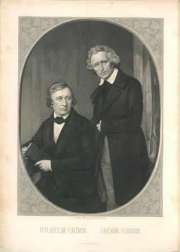|
Biografie Frații Grimm (Jakob și Wilhelm)
Frații Grimm (germană: Gebrüder Grimm) (Jacob și Wilhelm Grimm) au fost folcloriști, lingviști, filologi, doctori în drept, cunoscuți în toată lumea pentru colecția de basme publicată în două volume, care conține, printre multe altele, Albă ca zăpada, Cenușăreasa și Hansel și Gretel (primul volum în a apărut în 1812, iar al doilea volum în 1814). Frații Grimm și-au adus contribuția la formarea limbii germane, în special prin dicționarul Deutsches Wörterbuch (Cartea cu cuvinte germane) pe care l-au scris împreună și prin prima carte de fonetică/fonologie a limbii germane, Legea lui Grimm, scrisă doar de Jacob. Dicționarul Fraților Grimm avea 33 de volume și cântărea 84 kg.
***
Jakob Ludwig Karl Grimm wurde am 4.1.1785 in Hanau geboren, sein Bruder Wilhelm Karl Grimm am 24.2.1786 am gleichen Ort. Der Vater war Jurist. Die Kinder lebten die ersten Jahre ihrer Jugend in Steinau und sie besuchten das Lyzeum im Kassel. Seit 1829 bzw. 1839 waren sie Professoren in Kassel. Aufgrund ihrer Teilnahme am Protest der "Göttinger Sieben" wurden sie des Landes verwiesen. Seit etwa 1840 lebten beide in Berlin. Jakob Grimm starb am 20.9.1863 in Berlin, sein Bruder am 16.12.1859 am gleichen Ort.
Jacob and Wilhelm Grimm - famous for their classical collections of folk songs and folktales, especially for KINDER- UND HAUSMÄRCHEN (Children's and Household Tales); generally known as Grimm's Fairy Tales, which helped to establish the science of folklore. Stories such as 'Snow White' and 'Sleeping Beauty' have been retold countless times, but they were first written down by the Brothers Grimm. In their collaboration Wilhelm selected and arranged the stories, while Jacob, who was more interested in language and philology, was responsible for the scholarly work. The English writer Ford Madox Ford sees in his masterly guide The March of the Literature (1938) that their tales were more than a mere reflection of German romanticism.
Jacob Grimm was born in Hanau. His father, who was educated in law and served as a town clerk, died when Jacob was young. His mother Dorothea struggled to pay the education of the children. With financial help of Dorothea's sister, Jacob and Wilhelm were sent to Kasel to attend the Lyzeum. Jacob then studied law at Marburg. He worked from 1816 to 1829 as a librarian at Kasel, where his brother served as a secretary. Between 1821 and 1822 the brothers raised extra money by collecting three volumes of folktales. With these publications they wanted to show, that Germans shared a similar culture and advocate the unification process of the small independent kingdoms and principalities.
Altogether some 40 persons delivered tales to the Grimms. Their the most important informants included Dorothea Viehmann, the daughter of an innkeeper, Johann Friedrich Krause, an old dragoon, and Marie Hassenpflug, a 20-year-old friend of their sister, Charlotte, from a well-bred, French-speaking family. Marie's stories blended motifs from the oral tradition and Perrault's Tales of My Mother Goose (1697).
The brothers moved in 1830 Göttingen, Wilhelm becoming assistant librarian and Jacob librarian. In 1835 Wilhelm was appointed professor, but they were dismissed two years later for protesting against the abrogation of the Hannover constitution by King Ernest Augustus. In 1841 they became professors at the University of Berlin, and worked with DEUTSCHES WÖRTERBUCH. Its first volume appeared in 1854. The work, 16 volumes, was finished in the 1960s.
|




